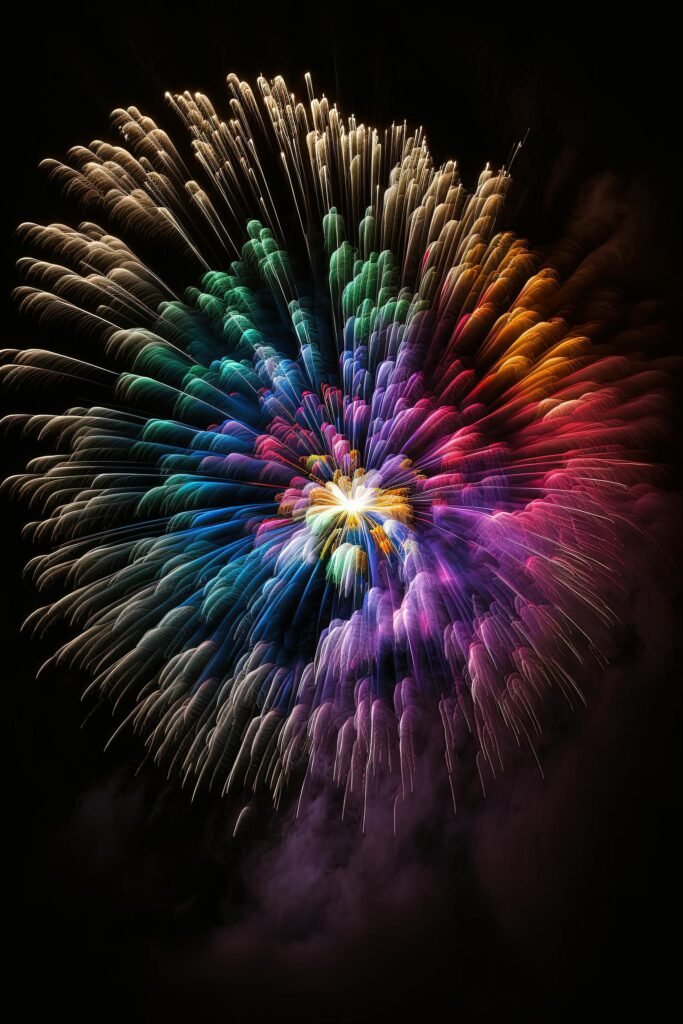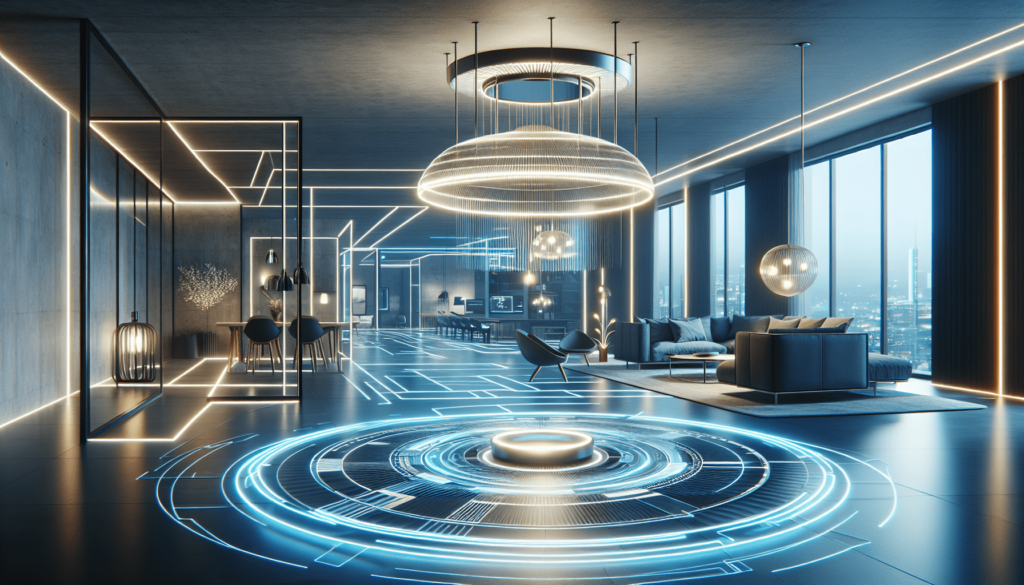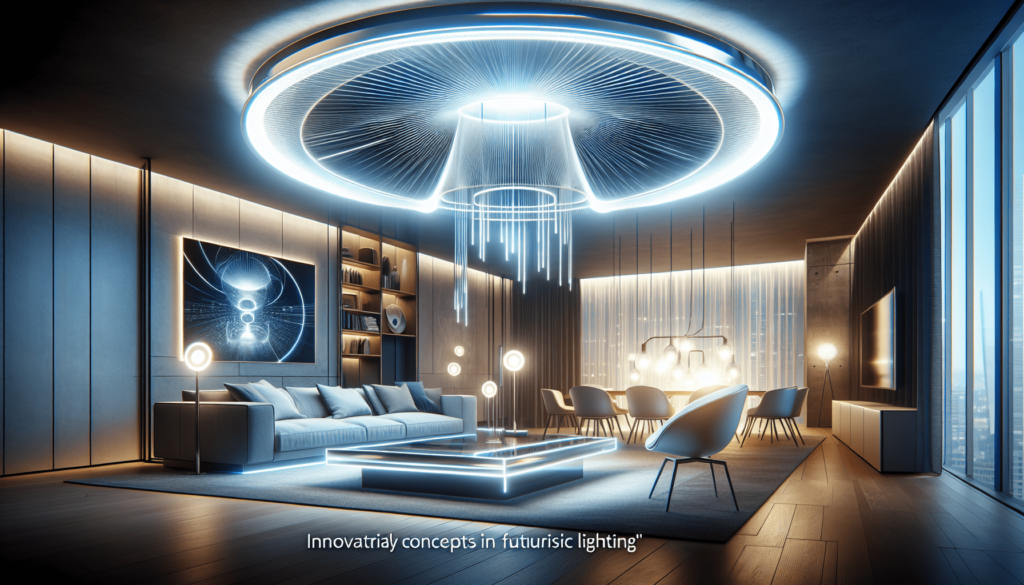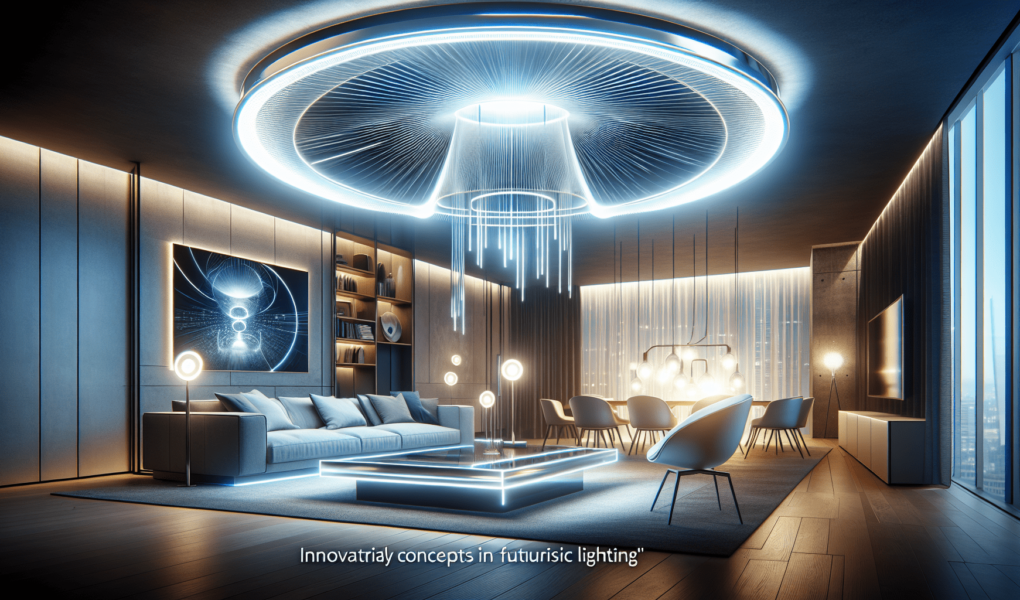Step into the future with innovative lighting concepts that will transform the way you illuminate your space. From mesmerizing holographic displays to smart lighting systems that adapt to your needs, these cutting-edge technologies are revolutionizing the way we think about lighting. Say goodbye to traditional fixtures and hello to a world where lighting becomes an integral part of your lifestyle. Whether you want to create an immersive experience or enhance productivity, these futuristic lighting concepts are sure to inspire and captivate.

1. Smart Lighting Systems
In today’s rapidly evolving world, smart lighting systems have emerged as a revolutionary concept, transforming the way we illuminate our homes and spaces. These cutting-edge lighting solutions not only provide advanced control options but also offer seamless integration with other smart home devices. With the ability to adjust brightness, color temperature, and even schedule lighting patterns, smart lighting systems allow you to create the perfect ambiance for any occasion.
Connected Lighting Solutions
One of the key features of smart lighting systems is their ability to be connected and controlled through various platforms. Whether it’s a smartphone app or a voice-activated assistant like Amazon Alexa or Google Assistant, you can easily manage your lights with just a few taps or voice commands. This integration allows for a truly connected home, where lighting can be synchronized with other smart devices, such as thermostats or security systems, for enhanced convenience and efficiency.
Integration with Smart Home Devices
Smart lighting systems are designed to seamlessly integrate with other smart home devices, creating a cohesive and interconnected ecosystem. Imagine waking up in the morning to the gentle glow of your bedroom lights, as they gradually brighten to mimic the rising sun. Or coming home after a long day, as the lights automatically turn on, adjusting to your preferred settings. With integration capabilities, your lights can work in harmony with other devices, creating an enhanced and personalized living experience.
Energy-Efficient Lighting Control
Smart lighting systems not only offer convenience but also play a crucial role in promoting energy efficiency. With features like occupancy sensors, your lights can automatically turn off when a room is unoccupied, eliminating unnecessary energy consumption. Dimming options allow you to adjust the level of brightness according to your needs, further reducing energy usage. These energy-efficient lighting controls not only benefit the environment but also result in long-term cost savings for homeowners.
2. Interactive Lighting Design
In the realm of futuristic lighting, interactive lighting design has taken center stage. This innovative concept allows lighting to respond to human interaction and create a truly immersive experience.
Motion-Activated Lighting
Motion-activated lighting systems utilize sensors to detect movement, instantly turning on or adjusting the lights as soon as someone enters a room. This not only provides convenience but also ensures safety by illuminating pathways and stairs automatically. Motion-activated lighting is particularly beneficial in areas such as hallways, bathrooms, and closets, where hands-free operation is desired.
Gestural Control for Customized Lighting
Imagine controlling your lights with a simple wave of your hand or a flick of your wrist. Gestural control technology allows for intuitive and personalized lighting control, where specific hand movements or gestures can trigger different lighting scenes or adjust brightness levels. This innovative approach to lighting design adds a touch of magic and interactivity to your space, making each interaction with your lights a memorable experience.
Responsive Lighting Systems
Responsive lighting systems take interactivity to the next level by analyzing the surrounding environment and adapting the lighting accordingly. For example, in a room with large windows, the lights can automatically adjust their intensity and color temperature to complement the natural light coming in. Similarly, responsive lighting can change its characteristics based on the time of day or the mood you want to create. By seamlessly responding to the changing environment, these lighting systems create a dynamic and engaging atmosphere.

3. Bioluminescent and Bioengineered Lighting
Drawing inspiration from nature, bioluminescent and bioengineered lighting concepts introduce a captivating blend of science and art, bringing natural light sources to new and unexpected places.
Biofabrication for Natural Light Sources
Biofabrication involves creating light-emitting materials using biological organisms or their components. Researchers are exploring the possibility of using bioluminescent bacteria or other organisms to produce sustainable and eco-friendly light sources. By harnessing the natural capabilities of these organisms, biofabrication offers a unique and visually captivating approach to lighting design.
Genetically Engineered Glow-in-the-Dark Plants
Scientists have been experimenting with genetically engineering plants to produce light through bioluminescence. By introducing specific genes into plant DNA, researchers have successfully created plants that emit a soft, natural glow in the dark. These glow-in-the-dark plants not only provide a visually stunning display but also offer a sustainable alternative to traditional lighting methods.
Bioluminescent Organisms for Illumination
Bioluminescent organisms, such as fireflies or certain types of algae, have captivated our imagination for centuries. Imagine a future where these organisms are harnessed to provide illumination in our living spaces. While still in the early stages of development, this concept holds great potential for creating enchanting and eco-friendly lighting installations that merge technology and nature in perfect harmony.
4. Holographic Lighting Displays
Holographic lighting displays have long been a staple of science fiction, but recent advancements in technology have brought this futuristic concept closer to reality. These displays utilize 3D projection mapping, virtual reality, and augmented reality to create captivating light-based experiences.
3D Projection Mapping
3D projection mapping is a technique that uses specialized projectors to display images or videos onto three-dimensional surfaces, such as buildings or statues. By carefully aligning the projected images with the contours of the object, the illusion of depth and movement is created, resulting in a mesmerizing visual spectacle. This technology has been used to transform architectural structures into dynamic canvases for artistic expression and storytelling.
Virtual Reality Lighting Environments
Virtual reality (VR) technology has the potential to transport us to entirely new worlds, and lighting plays a crucial role in creating immersive VR experiences. By precisely controlling the lighting within a virtual environment, designers can evoke specific moods and atmospheres, enhancing the overall realism and engagement. Whether exploring a virtual museum or embarking on a thrilling adventure, the lighting in the virtual world can make the experience truly unforgettable.
Immersive Augmented Reality Lighting
Augmented reality (AR) merges the virtual and physical worlds, overlaying digital information onto the real environment we perceive. AR lighting takes this concept further by dynamically incorporating virtual lighting elements into the real world. Imagine walking into a room where virtual light fixtures seamlessly blend with the physical ones, creating a surreal and immersive lighting experience. AR lighting opens up endless possibilities for creativity and personalization, transforming our perception of space and light.

5. Solar-Powered Lighting Innovations
As the world strives towards renewable energy solutions, solar-powered lighting innovations have gained significant traction. Harnessing the power of the sun, these solutions offer sustainable and eco-friendly alternatives to traditional lighting methods.
Solar Energy Harvesting Technologies
Solar energy harvesting technologies allow for the efficient capture and conversion of sunlight into usable electrical energy. Solar panels built into light fixtures or placed strategically on rooftops can collect solar energy throughout the day, storing it in batteries for later use. By utilizing this abundant and clean energy source, solar-powered lighting systems reduce dependency on traditional power grids and contribute to the reduction of carbon emissions.
Solar Street Lighting
Traditional street lighting relies heavily on electricity from the grid, making it costly and energy-intensive. Solar street lighting, on the other hand, utilizes self-contained units equipped with solar panels and batteries, offering a self-sustaining lighting solution. Not only do solar street lights reduce energy costs and carbon footprints, but they also enhance safety by providing well-lit streets and pathways even in remote areas without a reliable power supply.
Solar-Powered Light Fixtures for Indoor Spaces
Solar-powered light fixtures designed for indoor spaces allow homeowners and businesses to integrate sustainable lighting solutions into their interiors. These fixtures come equipped with solar panels or have the ability to wirelessly charge from solar-powered stations, eliminating the need for conventional electrical connections. Solar-powered interior lighting not only reduces electricity consumption but also adds a touch of eco-consciousness to your living or working environment.
6. Light Art Installations
Light art installations push the boundaries of traditional lighting design, transforming spaces into immersive works of art. Blending technology, creativity, and innovation, these installations offer a unique and awe-inspiring visual experience.
LED Light Sculptures
LED technology has revolutionized the world of lighting, and it has found its way into art installations as well. LED light sculptures utilize programmable LED strips or panels to create mesmerizing shapes and patterns that come to life with vivid colors and dynamic lighting effects. These sculptures can be customized to fit any space, from public parks to galleries, adding a touch of artistic brilliance to the surroundings.
Projection Art
Projection art is an artistic medium that uses light projectors to display images or videos onto various surfaces, such as buildings, walls, or sculptures. By combining carefully crafted visuals with precisely controlled lighting, projection artists can transform ordinary objects into captivating and dynamic works of art. Projection art installations have the power to change the perception of an entire space and engage viewers in a truly immersive experience.
Interactive Light Installations
Interactive light installations encourage active participation and engagement from the viewers. These installations often incorporate sensors or motion tracking technology, allowing the audience to interact with the lights and become an integral part of the artwork. Whether it’s triggering specific lighting effects with movements or creating collaborative light patterns through touch-sensitive surfaces, interactive light installations offer a unique and unforgettable experience that blurs the line between the viewer and the art.

7. OLED (Organic Light Emitting Diode) Lighting
OLED lighting represents a significant advancement in lighting technology, offering thin, flexible, and energy-efficient lighting solutions with unparalleled design possibilities.
Flexible Lighting Panels
OLED lighting panels are incredibly thin and flexible, allowing for unique and unconventional lighting designs. These panels can be bent, curved, or even rolled, enabling the integration of lighting into unconventional surfaces or objects. From lighting elements embedded in furniture to wearable lighting accessories, OLED panels provide designers with the freedom to explore new dimensions of form and function.
Transparent OLEDs
Transparent OLEDs take lighting design to the next level by incorporating transparency into the light-emitting surfaces. These panels allow light to pass through, creating a magical effect where the lighting seems to appear out of thin air. Transparent OLEDs can be used in a variety of applications, from interior design and architecture to consumer electronics and automotive displays, introducing a new layer of elegance and aesthetics into the world of lighting.
Energy-Efficient and Thin OLED Solutions
OLED technology offers exceptional energy efficiency, consuming less power compared to traditional lighting sources. Additionally, OLED panels generate very little heat, reducing energy loss and allowing for effective cooling solutions. With their ultra-thin structure, OLED lighting solutions are also space-saving, making them ideal for applications where size and weight constraints are important considerations. Whether it’s illuminating a futuristic workspace or enhancing the ambiance of a hospitality setting, OLED lighting delivers both style and efficiency.
8. Nanotechnology-Enabled Lighting
Nanotechnology has opened up a realm of possibilities in lighting design, enabling the creation of innovative materials and enhancing the characteristics of light itself.
Nanoparticle Coatings for Enhanced Light Reflection
Nanoparticle coatings can be applied to various surfaces to enhance light reflection or create unique visual effects. By manipulating the size and composition of nanoparticles, designers can control the way light interacts with these coatings, resulting in increased brightness, improved color rendition, or even iridescent qualities. Nanoparticle coatings offer endless opportunities for enhancing lighting design in both functional and aesthetic aspects.
Quantum Dot LEDs for Efficient and Vivid Lighting
Quantum dot LEDs (QLEDs) utilize nanoscale semiconductor particles called quantum dots to enhance the color quality and efficiency of traditional LEDs. Quantum dots can emit light of precise colors when stimulated by energy, resulting in vibrant and accurate color reproduction. By integrating quantum dots into LED lighting solutions, designers can achieve a wide color gamut, improved energy efficiency, and enhanced visual experiences across various applications, from displays to architectural lighting.
Nanowire-Based Lighting
Nanowire-based lighting presents a groundbreaking approach to lighting design, utilizing nanoscale wires to emit light efficiently. These ultra-thin wires, often made of semiconductor materials, have the ability to emit light when an electric current is applied. Nanowire-based lighting offers exceptional control over lighting properties, such as color temperature and intensity, while minimizing energy consumption. With further advancements, this technology has the potential to revolutionize the way we illuminate our spaces.

9. Human-Centric Lighting
Human-centric lighting design focuses on the influence of light on human health, well-being, and productivity. By mimicking natural light patterns and adjusting lighting characteristics according to human needs, human-centric lighting aims to optimize our daily experiences.
Circadian Rhythm Lighting
Circadian rhythm lighting aims to replicate the natural light variations that occur throughout the day, aligning our internal biological clock with external light cues. By adjusting color temperature, intensity, and directionality of light, circadian rhythm lighting supports a healthy sleep-wake cycle and promotes overall well-being. Such lighting systems can be particularly beneficial in healthcare environments, workplaces, and residential spaces, where the quality of light can significantly impact human health and performance.
Tunable White Lighting
Tunable white lighting allows for dynamic adjustment of color temperature, providing flexibility in creating desirable lighting environments. By mimicking the warm, soothing tones of sunrise or the cool, invigorating hues of daylight, tunable white lighting can enhance productivity, mood, and comfort. This technology finds applications in various settings, from offices and educational institutions to residential spaces and hospitality venues, offering personalized lighting experiences tailored to individual needs.
Dynamic Lighting for Health and Well-being
Dynamic lighting systems go beyond adjusting color temperature and intensity; they take into account factors such as the user’s preferences, activities, and the surrounding environment. These systems use advanced control algorithms to create lighting scenarios that promote concentration, relaxation, or any desired state of mind. By considering the specific needs of individuals or groups, dynamic lighting contributes to improved health, well-being, and productivity, adapting to the ever-changing demands of our modern lifestyles.
10. Minimalist and Integration-Focused Lighting Design
In an era where simplicity and integration are valued, minimalist lighting design approaches seek to blend lighting seamlessly into our surroundings while minimizing visual distractions.
Invisible Lighting Fixtures
Invisible lighting fixtures are designed to be hidden from view, allowing light to emanate without revealing the source. This approach eliminates visual clutter and creates a clean and minimalist aesthetic. Invisible fixtures can be recessed into ceilings, floors, or walls, casting light in an indirect and subtle manner, emphasizing the beauty of the illuminated space rather than the lighting itself.
Integrated Lighting in Furniture and Architecture
Integrated lighting design combines lighting fixtures with furniture or architectural elements, blurring the line between function and aesthetics. From lighted shelving units and embedded lighting in kitchen countertops to illuminated staircases and hidden light sources within structural elements, integrated lighting seamlessly merges with the overall design, enhancing functionality and creating a cohesive visual experience.
Seamless and Discreet Lighting Solutions
Seamless and discreet lighting solutions prioritize subtle yet effective illumination. These lighting designs focus on achieving uniformity and minimizing shadows or glare while avoiding obtrusive fixtures. By carefully considering the placement and output of light sources, seamless lighting solutions create harmonious and glare-free environments, offering a visually pleasing and comfortable experience for occupants.
In conclusion, these innovative concepts in futuristic lighting showcase the limitless possibilities of the evolving lighting industry. From smart systems that integrate with our homes to bioluminescent organisms that provide natural light sources, each concept represents a unique blend of technology, sustainability, and artistic expression. Whether it’s creating interactive experiences or harnessing the power of nanotechnology, these advancements in lighting design have the potential to transform our spaces, improve our well-being, and elevate our visual aesthetics. As we continue to push the boundaries of what is possible, the future of lighting holds exciting prospects, illuminating our lives in ways we could have only imagined.



